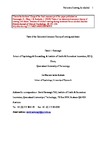Tests of the elaborated intrusion theory of craving and desire: Features of alcohol craving during treatment for an alcohol disorder
| dc.contributor.author | Kavanagh, DJ | |
| dc.contributor.author | May, J | |
| dc.contributor.author | Andrade, J | |
| dc.date.accessioned | 2012-05-18T13:28:03Z | |
| dc.date.accessioned | 2012-05-18T13:37:55Z | |
| dc.date.available | 2012-05-18T13:28:03Z | |
| dc.date.available | 2012-05-18T13:37:55Z | |
| dc.date.issued | 2010-12-24 | |
| dc.identifier.issn | 0144-6657 | |
| dc.identifier.issn | 2044-8260 | |
| dc.identifier.uri | http://hdl.handle.net/10026.1/995 | |
| dc.description | PubMed ID: 19364447 | |
| dc.description.abstract |
<jats:p><jats:bold>Objectives. </jats:bold> We tested predictions from the elaborated intrusion (EI) theory of desire, which distinguishes intrusive thoughts and elaborations, and emphasizes the importance of imagery. Secondarily, we undertook preliminary evaluations of the Alcohol Craving Experience (ACE) questionnaire, a new measure based on EI Theory.</jats:p><jats:p><jats:bold>Method. </jats:bold> Participants (<jats:italic>N</jats:italic>=232) were in correspondence‐based treatment trials for alcohol abuse or dependence. The study used retrospective reports obtained early in treatment using the ACE, and daily self‐monitoring of urges, craving, mood and alcohol consumption.</jats:p><jats:p><jats:bold>Results. </jats:bold> The ACE displayed high internal consistency and test – retest reliability and sound relationships with self‐monitored craving, and was related to Baseline alcohol dependence, but not to consumption. Imagery during craving was experienced by 81%, with 2.3 senses involved on average. More frequent imagery was associated with longer episode durations and stronger craving. Transient intrusive thoughts were reported by 87% of respondents, and were more common if they frequently attempted to stop alcohol cognitions. Associations between average daily craving and weekly consumption were seen. Depression and negative mood were associated with more frequent, stronger and longer lasting desires for alcohol.</jats:p><jats:p><jats:bold>Conclusions. </jats:bold> Results supported the distinction of automatic and controlled processes in craving, together with the importance of craving imagery. They were also consistent with prediction of consumption from cross‐situational averages of craving, and with positive associations between craving and negative mood. However, this study's retrospective reporting and correlational design require that its results be interpreted cautiously. Research using ecological momentary measures and laboratory manipulations is needed before confident inferences about causality can be made.</jats:p> | |
| dc.format.extent | 241-254 | |
| dc.format.medium | Print-Electronic | |
| dc.language | en | |
| dc.language.iso | en | |
| dc.publisher | Wiley | |
| dc.relation.replaces | http://hdl.handle.net/10026.1/994 | |
| dc.relation.replaces | 10026.1/994 | |
| dc.subject | Adult | |
| dc.subject | Aged | |
| dc.subject | Aged, 80 and over | |
| dc.subject | Alcohol Drinking | |
| dc.subject | Alcoholism | |
| dc.subject | Behavior, Addictive | |
| dc.subject | Cognitive Behavioral Therapy | |
| dc.subject | Ethanol | |
| dc.subject | Female | |
| dc.subject | Humans | |
| dc.subject | Imagination | |
| dc.subject | Male | |
| dc.subject | Models, Psychological | |
| dc.subject | Psychological Theory | |
| dc.subject | Psychometrics | |
| dc.subject | Retrospective Studies | |
| dc.subject | Sensation | |
| dc.subject | Surveys and Questionnaires | |
| dc.title | Tests of the elaborated intrusion theory of craving and desire: Features of alcohol craving during treatment for an alcohol disorder | |
| dc.type | journal-article | |
| dc.type | Article | |
| plymouth.author-url | http://gateway.webofknowledge.com/gateway/Gateway.cgi?GWVersion=2&SrcApp=PARTNER_APP&SrcAuth=LinksAMR&KeyUT=000268941200002&DestLinkType=FullRecord&DestApp=ALL_WOS&UsrCustomerID=11bb513d99f797142bcfeffcc58ea008 | |
| plymouth.issue | 3 | |
| plymouth.volume | 48 | |
| plymouth.publication-status | Published | |
| plymouth.journal | BRITISH JOURNAL OF CLINICAL PSYCHOLOGY | |
| dc.identifier.doi | 10.1348/014466508X387071 | |
| plymouth.organisational-group | /Plymouth | |
| plymouth.organisational-group | /Plymouth/Admin Group - REF | |
| plymouth.organisational-group | /Plymouth/Admin Group - REF/REF Admin Group - FoH | |
| plymouth.organisational-group | /Plymouth/Faculty of Health | |
| plymouth.organisational-group | /Plymouth/Faculty of Health/School of Psychology | |
| plymouth.organisational-group | /Plymouth/REF 2021 Researchers by UoA | |
| plymouth.organisational-group | /Plymouth/REF 2021 Researchers by UoA/UoA04 Psychology, Psychiatry and Neuroscience | |
| plymouth.organisational-group | /Plymouth/REF 2021 Researchers by UoA/UoA04 Psychology, Psychiatry and Neuroscience/UoA04 REF peer reviewers | |
| plymouth.organisational-group | /Plymouth/Research Groups | |
| plymouth.organisational-group | /Plymouth/Research Groups/Centre for Brain, Cognition and Behaviour (CBCB) | |
| plymouth.organisational-group | /Plymouth/Research Groups/Centre for Brain, Cognition and Behaviour (CBCB)/Behaviour | |
| plymouth.organisational-group | /Plymouth/Research Groups/Centre for Brain, Cognition and Behaviour (CBCB)/Cognition | |
| plymouth.organisational-group | /Plymouth/Research Groups/Institute of Health and Community | |
| plymouth.organisational-group | /Plymouth/Research Groups/Plymouth Institute of Health and Care Research (PIHR) | |
| plymouth.organisational-group | /Plymouth/Users by role | |
| plymouth.organisational-group | /Plymouth/Users by role/Academics | |
| dc.publisher.place | England | |
| dc.identifier.eissn | 2044-8260 | |
| dc.rights.embargoperiod | Not known | |
| rioxxterms.versionofrecord | 10.1348/014466508X387071 | |
| rioxxterms.licenseref.uri | http://www.rioxx.net/licenses/all-rights-reserved | |
| rioxxterms.type | Journal Article/Review |


